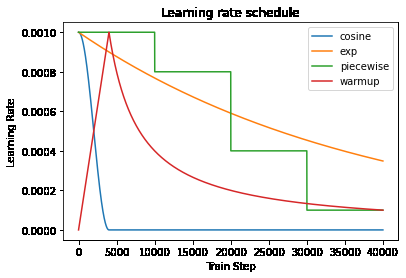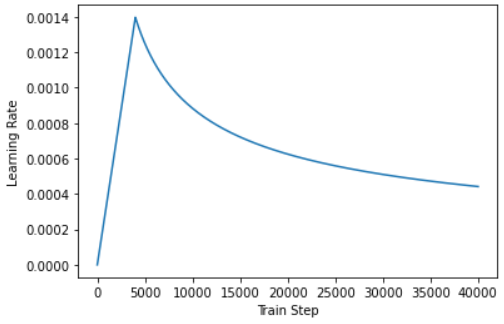Warmup小记
什么是warmup
热身,在刚刚开始训练时以很小的学习率进行训练,使得网络熟悉数据,随着训练的进行学习率慢慢变大,到了一定程度,以设置的初始学习率进行训练,接着过了一些inter后,学习率再慢慢变小;
学习率变化:上升——平稳——下降
为什么用warmup
- 有助于减缓模型在初始阶段对mini-batch的提前过拟合现象,保持分布的平稳
- 有助于保持模型深层的稳定性
可以认为,刚开始模型对数据的“分布”理解为零,或者是说“均匀分布”(当然这取决于你的初始化);在第一轮训练的时候,每个数据点对模型来说都是新的,模型会很快地进行数据分布修正,如果这时候学习率就很大,极有可能导致开始的时候就对该数据“过拟合”,后面要通过多轮训练才能拉回来,浪费时间。当训练了一段时间(比如两轮、三轮)后,模型已经对每个数据点看过几遍了,或者说对当前的batch而言有了一些正确的先验,较大的学习率就不那么容易会使模型学偏,所以可以适当调大学习率。这个过程就可以看做是warmup。
当模型训到一定阶段后(比如十个epoch),模型的分布就已经比较固定了,或者说能学到的新东西就比较少了。如果还沿用较大的学习率,就会破坏这种稳定性,用我们通常的话说,就是已经接近loss的local optimal了,为了靠近这个point,我们就要慢慢来。
这里只摘录了一小段,参考文献 [1] 解释的很好。
learning rate schedule
warmup和learning schedule是类似的,只是学习率变化不同。如图

learning rate schedule
tensorflow 中有几种不同的learning rate schedule,以上图的3种为例,更多schedule可以直达官网
# CosineDecay
cosine_learning_rate_schedule = tf.keras.optimizers.schedules.CosineDecay(0.001,4000)
plt.plot(cosine_learning_rate_schedule(tf.range(40000, dtype=tf.float32)),label="cosine")
# ExponentialDecay
exp_learning_rate_schedule = tf.keras.optimizers.schedules.ExponentialDecay(
0.001, 4000, 0.9, staircase=False, name=None
)
plt.plot(exp_learning_rate_schedule(tf.range(40000, dtype=tf.float32)),label="exp")
# PiecewiseConstantDecay
boundaries = [10000, 20000,30000]
values = [0.001, 0.0008, 0.0004,0.0001]
piecewise_learning_rate_schedule = tf.keras.optimizers.schedules.PiecewiseConstantDecay(
boundaries, values)
plt.plot([piecewise_learning_rate_schedule(step) for step in tf.range(40000, dtype=tf.float32)],label="piecewise")
# 自定义 Schedule
my_learning_rate_schedule = MySchedule(0.001)
plt.plot([my_learning_rate_schedule(step) for step in tf.range(40000, dtype=tf.float32)],label="warmup")
plt.title("Learning rate schedule")
plt.ylabel("Learning Rate")
plt.xlabel("Train Step")
plt.legend()
# 自定义 Schedule
class MySchedule(tf.keras.optimizers.schedules.LearningRateSchedule):
def __init__(self, initial_learning_rate, warmup_steps=4000):
super(MySchedule, self).__init__()
self.initial_learning_rate = initial_learning_rate
self.warmup_steps = warmup_steps
def __call__(self, step):
if step > self.warmup_steps:
return self.initial_learning_rate * self.warmup_steps * step ** -1
else:
return self.initial_learning_rate * step * (self.warmup_steps ** -1)
warmup in transformer
Noam Optimizer
class CustomSchedule(tf.keras.optimizers.schedules.LearningRateSchedule):
def __init__(self, d_model, warmup_steps=4000):
super(CustomSchedule, self).__init__()
self.d_model = d_model
self.d_model = tf.cast(self.d_model, tf.float32)
self.warmup_steps = warmup_steps
def __call__(self, step):
arg1 = tf.math.rsqrt(step)
arg2 = step * (self.warmup_steps ** -1.5)
return tf.math.rsqrt(self.d_model) * tf.math.minimum(arg1, arg2)
learning_rate = CustomSchedule(d_model)
optimizer = tf.keras.optimizers.Adam(learning_rate, beta_1=0.9, beta_2=0.98,
epsilon=1e-9)
temp_learning_rate_schedule = CustomSchedule(128)
plt.plot(temp_learning_rate_schedule(tf.range(40000, dtype=tf.float32)))
plt.ylabel("Learning Rate")
plt.xlabel("Train Step")

关于warmup参数
一般可取训练steps的10%,参考BERT。这里可以根据具体任务进行调整,主要需要通过warmup来使得学习率可以适应不同的训练集合,另外我们也可以通过训练误差观察loss抖动的关键位置,找出合适的学习率。[4]
references
【1】神经网络中 warmup 策略为什么有效;有什么理论解释么? - 香侬科技的回答 - 知乎 https://www.zhihu.com/question/338066667/answer/771252708
【2】tf官方文档 tf.keras.optimizers.schedules. https://www.tensorflow.org/versions/r2.6/api_docs/python/tf/keras/optimizers/schedules
【3】理解语言的 Transformer 模型. https://www.tensorflow.org/tutorials/text/transformer#优化器(optimizer)
【4】聊一聊学习率预热linear warmup. https://cloud.tencent.com/developer/article/1929850



